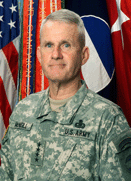Incident: Habibullah tortured to death
Habibullah will be a spirited and defiant prisoner. He spat on his torturers, and according to reports, after one soldier gave him a cavity search, Habibullah kneed him in the groin.
By 02 December, he will have already been beaten to the extent that he can no longer bend his legs to sit in a chair. He will also be coughing up phlegm, limping, and his right foot will be swollen. Yet he will remain unbroken.
"Once they asked him if he wanted to spend the rest of his life in handcuffs," Mr. Baerde [his interpreter] said. "His response was, 'Yes, don't they look good on me?'"By 03 December he will be found dead, still tethered to the ceiling as his torturers left him.
In several month's time, General McNeill will give statements to the press. General McNeill will be quoted denying that prisoners had been chained to the ceiling or or held in chains attached to the ceiling (source: NYT). From the article:
"Our interrogation techniques are adapted," [General McNeill] said. "They are in accordance with what is generally accepted as interrogation techniques ..."As described in an article for the International Herald Tribune:
Military spokesmen maintained that both men had died of natural causes, even after military coroners had ruled the deaths homicides. Two months after those autopsies, the American commander in Afghanistan, then-Lt. Gen. Daniel K. McNeill, said he had no indication that abuse by soldiers had contributed to the two deaths. The methods used at Bagram, he said, were "in accordance with what is generally accepted as interrogation techniques."

Lt. Gen. Daniel K. McNeill.
----
For a timeline and further reading, see this blog's entry on Dilawar. He was another detainee who was tortured to death at Bagram around the same time.



0 Comments:
Post a Comment
<< Home